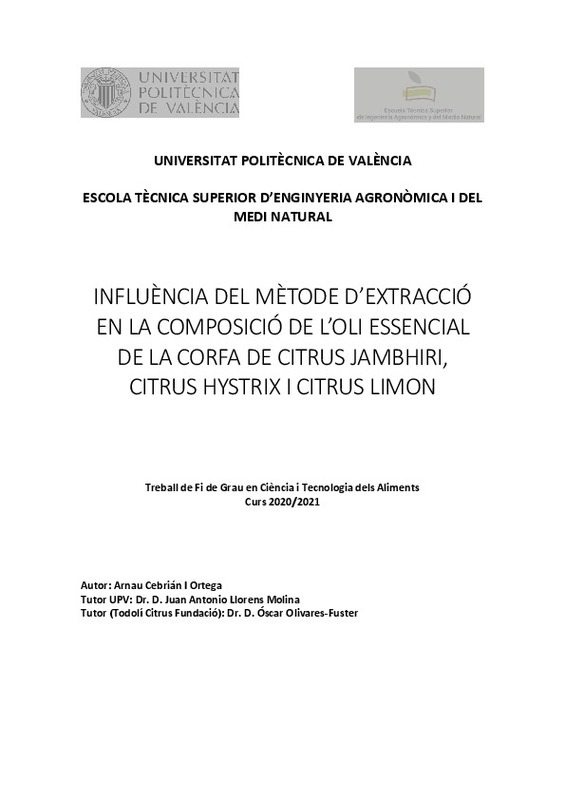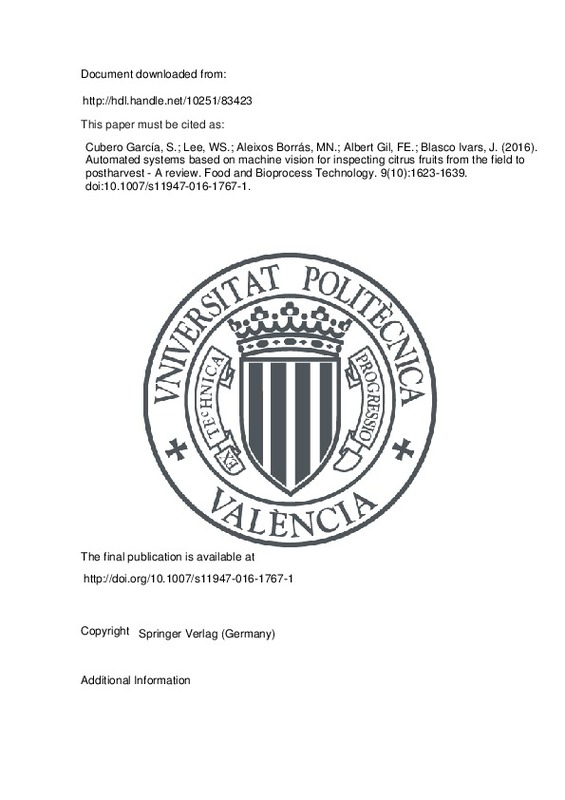|
Resumen:
|
[CA] Els olis essencials son substàncies intensament aromàtiques responsables de les fragàncies de
diferents òrgans vegetals, com poden ser flors, fulles i fruits. Aquests olis tenen múltiples
aplicacions ...[+]
[CA] Els olis essencials son substàncies intensament aromàtiques responsables de les fragàncies de
diferents òrgans vegetals, com poden ser flors, fulles i fruits. Aquests olis tenen múltiples
aplicacions en la indústria alimentària (additius, conservants, aromatitzants...). És per aquesta
raó que l’estudi de la composició química i quantificació dels seus components té gran interès. L’objectiu del treball és estudiar la influència de tres mètodes d’extracció en la composició
química, tant qualitativa com quantitativa, de l’oli essencial de tres espècies de cítrics; Citrus
jambhiri Lush., C. hystrix DC. y C. limon (L.) Burm. f. cultivar Rugoso. El material vegetal del que hem disposat per l’elaboració del treball prové de la col·lecció de Todolí Citrus Fundació. L’obtenció d’olis essencials de fruits cítrics, localitzats principalment al flavedo, pot realitzar-se fent servir diversos mètodes d’extracció. En aquest cas, els mètodes utilitzats han estat: l’obtenció directa per capil·laritat a partir de les vesícules que contenen l’oli essencial, la hidrodestil·lació amb un equip Clevenger i l’extracció amb dissolvents orgànics assistida per ultrasò i centrifugació. Per a les mostres obtingudes per extracció directa a partir de les vesícules d’oli, l’anàlisi
qualitatiu dels extractes s’ha realitzat per cromatografia de gasos amb detectors
d’espectroscopia de masses. L’anàlisi quantitatiu ha estat dut a terme mitjançant l’ús del
detector per ionització de flama. Per als extractes obtinguts per centrifugació i per
hidrodestil·lació s’ha realitzat una quantificació aproximada a partir de les àrees dels pics dels
cromatogrames. Després d’aquests anàlisis, pel que fa a la composició dels olis, s’ha observat una clara influència del mètode d’extracció de l’oli essencial en el seu perfil. Aquesta influència és més marcada al C. hystrix degut al seu perfil notablement més complex, on la presencia de compostos oxigenats és major.
[-]
[EN] Essential oils are intensely aromatic substances responsible for the fragrances of different plant organs, such as flowers, leaves and fruits. These oils have multiple applications in the food industry (additives, ...[+]
[EN] Essential oils are intensely aromatic substances responsible for the fragrances of different plant organs, such as flowers, leaves and fruits. These oils have multiple applications in the food industry (additives, preservatives, flavourings...). It is for this reason that the study of the chemical composition and quantification of its components has great interest.
The objective of the work is to study the influence of three extraction methods on the chemical composition, both qualitative and quantitative, of the essential oil of three varieties of citrus fruits; Citrus jambhiri Lush., Citrus hystrix DC. and Citrus limon (L.) Burm. f. crop Rough.
The plant material from which we have prepared the work comes from the collection of Todolí Citrus Foundation. Essential oils of citrus fruits, located mainly to the flavedo, can be obtained using several extraction methods. In this case, the methods used have been: the direct production by capillarity from the vesicles containing the essential oil, the hydrodistillation with a Clevenger equipment and the extraction with organic solvents assisted by ultrasound and centrifugation.
For samples obtained by direct extraction from oil vesicles, the qualitative analysis of the extracts has been performed by gas chromatography with mass spectroscopy detectors. The evaluation of the extraction performance by hydrodistillation was carried out gravimetrically by evaporation of the dichloromethane extract with a rotavapour. Quantitative analysis has been carried out using the flame ionization detector. For extracts obtained by hydrodistillation, the calculation of response factors for methyl octanoate has been applied as an internal standard. With the extracts obtained by centrifugation, an approximate quantification was made from the areas of the chromatograms peaks.
After these analyses, in terms of the composition of the oils, a clear influence of the method of extraction of the essential oil on their profile has been observed. This influence is more pronounced on C. hystrix due to its significantly more complex profile, where the presence of oxygenated compounds is greater.
[-]
|










